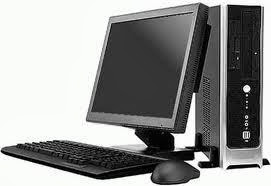Since 1970 there are two developments which are considered as the fourth generation computer. First, the use of Large Scale Integration (LSI) which is also called by the name Bipolar Large Large Scale Integration. LSI is a solidification of thousands of ICs that put together in an IC chip called chip. The term chip is used to denote a rectangular slab containing an integrated circuit IC. LSI then developed into a Very Large Scale Integration (VLSI) which can accommodate tens of thousands to hundreds of thousands of ICs. Further development of micro computers using microprocessors and semiconductor chips to form the internal computer memory while the previous generation using magnetic core storage.
Example of fourth generation computer: PC (Personal Computer). This generation of computer IC technology that distinguishes between the computer and the micro mini and main frame computers. Some IC technology is the generation Processor 6086, 80286, 80386, 80486, Pentium I, Celeron, Pentium II, Pentium III, Pentium IV, Dual Core, Core to Duo, Quad Core, Core i3, i5, i7, Ivy bridge (made by Intel), and there is also the AMD K6, Athlon, etc. This generation also embodies a class of computer called a super computer.
Intel in 1971 introduced a 4-bit microcomputer that uses a processor chip with 4004 names containing 230 transistors and runs at 108 KHz (Kilo-Hertz) and can execute 60,000 operations per second. Continued in 1972, Intel introduced the 8008 microcomputer that processes 8 bits of information at a time. Furthermore, the 8080 microprocessor was made in 1974, and is the first general-purpose processor. Previous processors 4004 and 8008 are designed for specific application needs, and 8080 processors have the ability to more quickly and have the richer instruction set, as well as having a larger addressing capabilities. In this fourth generation is still a color display monitor (green color).
Posted by , Published at 6:12 AM and have
0
comments






No comments:
Post a Comment